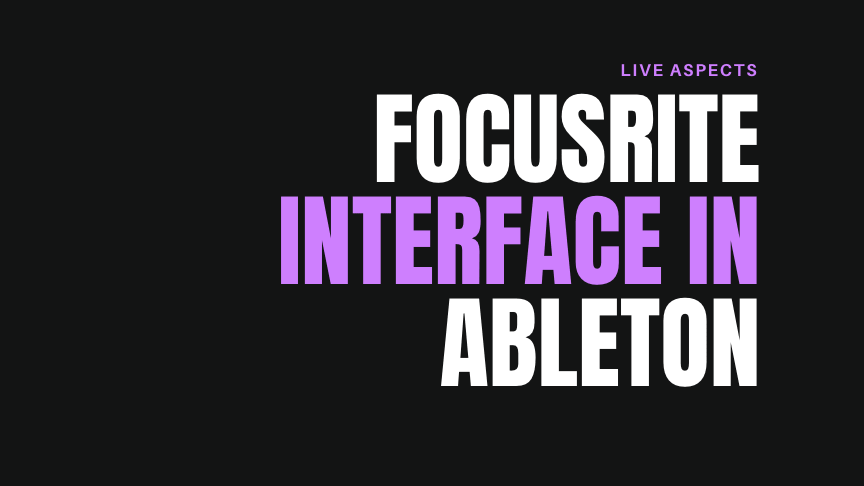

- How to set up audio interface and mic in ableton serial#
- How to set up audio interface and mic in ableton Patch#
- How to set up audio interface and mic in ableton software#
Patch bays may seem a little bit confusing at first, but they'll make complete sense once you wrap your head around the conept. The connections made on the back of your patch bay are permanent, while the connections on the front are temporary. Connections are formed by plugging 1/4” patch bay cables into the 1/4” jacks on the front panel of the unit. On top of allowing you to route audio signal in creative ways, patch bays prevent audio cable degradation all the cables plugged into the rear of the unit are left in place. A rack mount allows you to screw your outboard gear into it, making it easy to store multiple hardware units near one another. You may be able to get away with resting a single piece of outboard gear on a desk, but you’re going to want to get your hands on a rack mount at some point.
How to set up audio interface and mic in ableton serial#
To some degree this is true, but by using a patch bay, you’ll be able to quickly switch between recording different pieces of gear, and chain audio devices together to perform serial processing. It may seem like the number of pieces of outboard gear that you can use is limited based on the number of inputs your audio interface has. This set up assumes that you’re working with an audio signal that you’ve already recorded and that you want to process further using a single piece of outboard gear. Then, you run the processed signal from the output(s) of your outboard gear to the input(s) of your audio interface. To start, you run line level signal from your audio interface to the input(s) of the outboard gear. Integrating a single piece of outboard gear into your studio is a simple process. The microphone inputs are switchable with the first 4 line inputs, so I can potentially record 8 line level signals at one if I choose not to connect any microphones. This means I can connect 2 guitars, 4 microphones, and 4 line level signals at once. Your audio interface likely has at least a couple of built-in mic preamps, so a standalone preamp probably isn’t required.įor example, on my Apollo x8, there are 2 Hi-Z inputs, 4 microphone inputs along with 4 built-in mic preamps, and 8 line level inputs. To bring a microphone’s signal up to line level, you’ll need to run it through a mic preamp. You can bring an instrument level signal up to line level by either running it through a standalone DI box or running it through one of the HI-Z (high impedance) inputs on your audio interface. Instrument level signal is produced by guitars and basses and mic level signal is generated by microphones these types of signals need to be amplified to line level signal before getting run through outboard devices like compressors, EQs, saturators, etc. There are 3 different levels of analog signal that you’ll be commonly working with. Instrument Level, Mic Level, and Line Level Signal Unfortunately, the wildly popular Scarlett 2i2 will not allow you to use outboard gear because it only has two outputs for your monitors.


This will allow you to take advantage of either two pieces of mono outboard gear, or one piece of stereo outboard gear the left channel and right channel each require their own input/output. At a minimum, you need an interface with two line outputs (on top of your main monitor outs) and two line inputs. Larger studios may actually need to use multiple audio interfaces depending on how much outboard gear they have.Īn audio interface with many ins/outs will allow you to send signal to a substantial number of outboard units and record multiple tracks at once.

It converts analog signal to digital signal and vice versa, meaning you require an audio interface to connect analog equipment to your computer. The keystone of a studio containing outboard gear is undoubtedly the audio interface. Plugin Alliance, Slate Digital, and Soundtoys also make very powerful analog-modeled plugins, and they don’t require the use of dedicated hardware. However, the caveat is that you need to own one of Universal Audio’s interfaces to run their plugins. The company modeling analog equipment the best, in my opinion, is Universal Audio with their UAD plugins.
How to set up audio interface and mic in ableton software#
Software manufacturers are now capable of recreating the sound of hardware processing units with pinpoint accuracy. There’s a sound quality, ease-of-use, and fun component associated with adding outboard gear to your studio I’ll be showing you how you can effectively integrate this type of equipment into your existing setup.īefore catfishing you into rather expensive music production territory, I should mention that a lot of outboard gear is available in the form of analog-modeled plugins. In today’s musical climate, you can make fantastic music using just your computer, but that doesn’t mean that outboard gear like hardware compressors, EQs, reverbs, delays, and mic preamps are irrelevant. There’s nothing quite as exciting as walking into a studio packed to the brim with analog equipment.


 0 kommentar(er)
0 kommentar(er)
